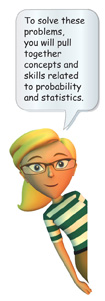11 Pull It All Together

BIG idea Probability
Various counting methods (such as permutations and combinations) can help you analyze situations and develop theoretical probabilities.
Task 1
Suppose you have n items from which you choose r at a time. Explain why you must divide the number of permutations
Task 2
Suppose you stack three identical number cubes. It is possible to have no sides, two sides, or all four sides of the stack showing all the same number. (Note that if one side of a stack shows all the same number, then the opposite side must as well.)
How many ways are there to stack three standard number cubes so that at least two sides of the stack show all the same number? If you can rotate a stack so that it is the same as another, count them as the same arrangement.

0 sides

2 sides

4 sides
BIG idea Data Collection and Analysis
Standard measures that describe data from a real-world situation can help you make estimates or decisions about the situation, or predictions about future occurrences.
Task 3
Show all of your work and explain your steps.
- Find the mean and standard deviation of the sums you should get when you roll two standard number cubes.
- Suppose you can replace one number cube with a nonstandard number cube, where any of the numbers 1 through 6 can appear on multiple faces. How can you arrange the numbers on the nonstandard cube so that the mean of the rolls is the same as that of two standard number cubes, but the standard deviation is as large as possible? What is this value?
Table of Contents
- 5-1 Polynomial Functions
- 5-2 Polynomials, Linear Factors, and Zeros
- 5-3 Solving Polynomial Equations
- 5-4 Dividing Polynomials
- 5-5 Theorems About Roots of Polynomial Equations
- 5-6 The Fundamental Theorem of Algebra
- 5-7 The Binomial Theorem
- 5-8 Polynomial Models in the Real World
- 5-9 Transforming Polynomial Functions




